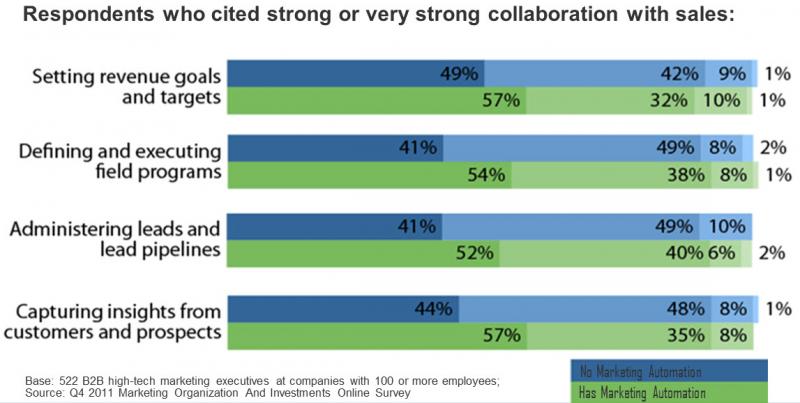Lead-To-Revenue Management Fosters Marketing/Sales Alignment
 I’ve been having a lot of conversations, recently, about sales and marketing alignment. (Well, honestly, who working in B2B marketing hasn’t?) In Forrester’s most recent Marketing Organization and Investment Survey, we asked the respondents (522 B2B marketing execs from companies with more than 100 employees) about the quality of collaboration between sales and marketing. Fifty-seven percent of marketing execs reported weak or mixed collaboration with sales when "defining lead qualification criteria" and "administering leads and lead pipelines." Those numbers underscore the much-storied rift between marketing and our colleagues in sales.
I’ve been having a lot of conversations, recently, about sales and marketing alignment. (Well, honestly, who working in B2B marketing hasn’t?) In Forrester’s most recent Marketing Organization and Investment Survey, we asked the respondents (522 B2B marketing execs from companies with more than 100 employees) about the quality of collaboration between sales and marketing. Fifty-seven percent of marketing execs reported weak or mixed collaboration with sales when "defining lead qualification criteria" and "administering leads and lead pipelines." Those numbers underscore the much-storied rift between marketing and our colleagues in sales.
For a while I have been saying that a managed lead-to-revenue process will catalyze a new collaborative relationship between sales and marketing. It makes sense to the point of being incandescently obvious; calibrating sales and marketing around a shared revenue goal is the basis for true alignment. But, until there is proof, it’s a hypothesis. And, now there’s proof.
In our study, we found that companies who have implemented a marketing automation solution (a proxy for a more managed process) reported significantly higher levels of collaboration between sales and marketing, across a number of different dimensions.
The marketing automation adopters had a 13% collaboration advantage (54% to 41%) in defining and executing field programs. This makes sense. The ability to track the revenue impact of marketing programs can finally put an end to spirited debates over “trade show vs. tele-prospecting” and “white paper syndication vs. golf outing.” Now we can make a bias-free decision to euthanize under-performing pet programs, and double down on the investments that are actually delivering revenue results.
Fifty-seven percent of the marketing automation adopters reported strong collaboration in capturing insight from customers and prospects, compared to 41% of those who are not automated. By providing insight into the prospect’s behavior and experience across all channels (website, campaigns and social) your sales force can have better conversations, engage in a meaningful way, and close more deals, faster.
Administering Leads and Lead Pipelines posted a positive collaborative advantage of 12 percent. Just as you suspected, there is a better tool than Excel to distribute and manage the follow-up on tradeshow leads!
The smallest differential (at 3%) was for the "blocking and tackling" activity of defining lead qualification criteria. This activity was also the most problematic, overall, for those companies with L2R automation software with only 46% citing strong collaboration – the only dimension that scored below the 50% mark. Marketing automation requires definition of a fairly robust lead taxonomy which is implemented through the somewhat inflexible mechanism of lead scoring.
In our research, we found some significant differences in the characteristics used to define a sales-ready lead. Fifty percent of the top performers (those who exceeded their revenue goals) required a defined time frame for purchase, compared with only 37% of the worst performers (those who missed). Top performers were also more likely to require a recognized need or pain (at 29% versus 14%). Marketing needs to hold our ground on definition of sales-ready lead. The more fully nurtured our leads, the better will be the effect on the sales pipeline and outcomes. That’s a difficult discussion with a sales force that is clamoring for “more leads, please” – but stand firm. Of course, collaboration is a matter of give and take, so flex a little as well.
It’s not surprising that sales and marketing collaboration is still a challenge, as the two organizations have been operating with different goals, metrics and timescales for several decades. But, it is heartening that automating the end-to-end lead to revenue process is having such an impact on improving things.
